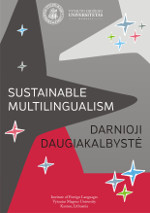Tandeminis kalbų mokymasis: elementai, principai ir perspektyvos
Language Learning in Tandem: Elements, Principles and Perspectives
Author(s): Jurgita CvilikaitėSubject(s): Foreign languages learning
Published by: Vytauto Didžiojo Universitetas
Keywords: tandem learning; tandem partners; autonomy; reciprocity; foreign language acquisition
Summary/Abstract: The article describes the method of tandem learning and defines its key elements – the roles of tandem partners, the form of learning sessions and learning material. Tandem language learning takes place between two native speakers who are learning each other‘s language. Based on the principles of autonomy and reciprocity, the method provides a different way of learning a foreign language, where the process is organised and planned solely through collaboration between tandem partners. While learning in tandem, they improve foreign and native language knowledge and develop intercultural communication, learning in collaboration, learning to learn and other important competences. The article presents the results of a survey which was designed to find out whether tandem learning is known in Lithuania. The survey also reavealed the apeal of tandem learning to the respondents. It was interesting to know how many respondents would be motivated to improve foreign language skills or to start learning a new language via tandem learning. The results of the survey show that only one fifth of the respondents knows the concept of tandem learning and more than a third doubts that this method could become popular in Lithuania. However a majority of the respondents would agree to learn in tandem. The most acceptable learning methods for the respondents are learning in groups or privately. Individual learning was mentioned only by a minority of the respondents. Lack of time and money were the most popular among the factors hindering learning languages. The survey established that tandem learning is not well known in Lithuania and is rarely employed. Although it is claimed that tandem learning is more an auxilliary method, it would be useful both for language learners and scientists researching learners‘ behaviour in various situations, motivation, learning achievements and other areas.
Journal: Darnioji daugiakalbystė
- Issue Year: 2014
- Issue No: 4
- Page Range: 100-114
- Page Count: 15
- Language: Lithuanian

